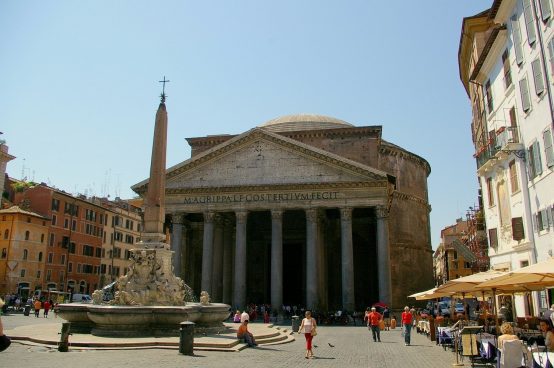The Metaphysical Nature of Our City Temples and Tombs

Adolf Loos, founding father of architectural modernism, maintained that only in two of its applications is architecture an art—in the temple and the tomb. For it is only in these structures, built to house the non-existent, that architecture escapes from its everyday function as a shelter against an inhospitable reality. The tomb and the temple are ostensibly built as monuments to the hero or the god contained in them. In fact they are monuments to our own ideals, giving form and mass to purely mental entities.
Tombs, temples, and memorials form the heart of our ancient settlements, marking the public squares, the crossroads and the places of pilgrimage. They are the nodes of the urban network, and the streets radiate out from them, carrying the message of belonging to the furthest reaches of the city. Every town in Europe is built around a church, and public spaces are marked by monuments and chapels, reminding us that the place has a meaning more durable than the people who reside there.
The twentieth century saw mass urbanization on both our continents. Suburbs grew around the existing hubs; inner cities decayed as their edges receded; buildings rose high above the wrecked streets of the old neighborhoods and automobiles drove swathes of devastation through the city centers. People moved out to the suburbs, and into the suburbs from the fields. And yet no new places were created. The suburbs were no-places, and the city itself became a concrete platform, on which the glass boxes could be shifted back and forth like pieces on a chess-board. In an astonishingly short time, many of the places that we knew had disappeared, and no places had come in their stead.
The causes of this tragedy are complex, and there is no simple remedy. Traveling around England in order to examine the new buildings that are being squeezed into our towns or dropped in our fields, asking myself why they are often so ugly and what might be done to change this, I have been struck by the physical difference between the old and the new. And I have been even more struck by a deeper metaphysical difference. The old buildings belong in the places that they create; the new buildings typically belong nowhere, and create a nowhere wherever they are constructed. Physically the old city center is a space; metaphysically, however, it is a place, a somewhere to which buildings, people and the institutions that unite them can belong. But the new developments are spaces that refuse to be places, spaces where nothing belongs.
At first, I thought that the placeless character of modern housing is a matter of style—the modern materials and proportions, the grammarless disposition of windows and doors, the random orientation along cul-de-sacs that join nothing to nothing. But it soon became clear that the style made next to no difference to the effect. Meticulous steel and glass edges à la Mies van der Rohe are as out of place as beefy classicism à la Stanford White. All are out of place because there is no place to be in. So what makes a place? How does the peculiar experience of belonging enter human consciousness, and to what end?
These questions return me to Adolf Loos’s observation concerning the temple and the tomb. In constructing these memorials to the non-existent we are fixing ourselves to a space. Temples and tombs are massive, immovable, as though the spirit contained in them has been fixed forever to the ground. The god and the hero cling to their allotted space with all the force of the imagination, and this causes us to reimagine that space as a somewhere to be shared and defended. In a space that has become a place it is not the body only but also the soul that finds a home. So much recent attempt at placemaking fails because it bypasses those core emotions. Yet how can you make a place for people if you do not first make a place for their heroes and their gods? We settle down by inviting our gods and heroes to settle beside us. And in that way the place is sanctified as ours.
When the Antifa activists gather in the squares to pull the statues from their pedestals and the busts from their plinths, they are sending the message that this place is not ours, that we do not belong here, and that we want to start again outside the community that brought us into being. And the result of their destructive pranks will surely be no different from the result of so much modern building—the replacement of somewhere by nowhere. And I suspect that that is where we are going.
Roger Scruton is The American Conservative’s New Urbanism Fellow.
Comments